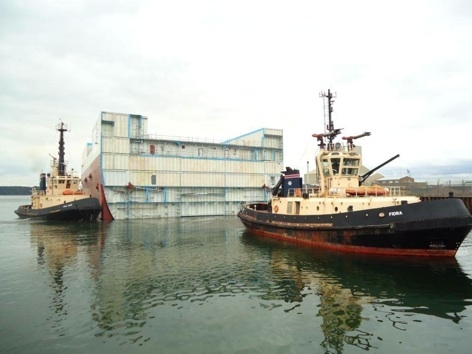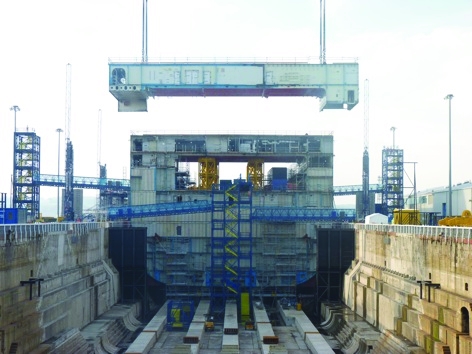As I wrote my last blog the 8000 tonne centre section of the aircraft carrier HMS Queen Elizabeth, Lower Block 03 (LB03), was being loaded onto the semi-submersible barge the “AMT Trader” at Govan in preparation for her sea voyage around the north of Scotland to Rosyth on the Firth of Forth.
At the same time a team of cyclists was preparing to “Beat the Block” by cycling north from Glasgow across the Great Glen and back south to Rosyth. I can now tell you that both the barge and the cyclists successfully completed their journeys, arriving safely the Rosyth Dockyard. By duly beating the block – with just minutes to spare - the cyclists raised more than £28k for the Royal Navy and Royal Marines Charity, a fantastic effort by all concerned.

Having safely arrived at Rosyth, the sea fastenings attaching LB03 to the barge were cut, and preparations were made for floating the block off the barge and dock it down in the newly prepared dry dock where the giant aircraft carriers will be assembled. The float off operation took place on Tuesday 30th August, having been postponed by a day due to very strong winds. The barge was towed out to a part of the estuary where the sea bed is flat and the water depth suitable. Here it was anchored fore and aft. Then, at first light, ballasting the barge commenced so that by mid-morning it was effectively lying on the sea bed at low tide.

In the early afternoon, as the tide flooded back in, the block floated off from the submerged barge and was towed by a group of tugs back to the dockyard where it was docked in the dry dock the following morning. The best vantage point for viewing the float off was from Blackness Castle on the north shore of the Forth. The castle, which is a Scottish Heritage site, sits on a headland and gives an excellent viewing position. Myself and several of my colleagues, all dressed in Aircraft Carrier Alliance high visibility jackets, descended on the castle to watch the operation. I was a little worried that the Scottish Heritage workers might object, but they made us very welcome, no doubt helped by the roaring trade they did in supplying us with warm cups of coffee on what was a surprisingly cold late August day.
The dry docking of LB03 was pretty much straight out of the text book and meant the programme was almost ready to enter the assembly phase.
Soon after, the upper block, CB03, which completes the structure up to the flight deck, was delivered to Rosyth from A&P’s yard at Hebburn on the Tyne. It was constructed in four parts, each weighing around 800 tonnes, therefore capable of being lifted by the 1000 tonne capacity Goliath Crane recently installed across the assembly dock. Finalisation of commissioning of the Goliath crane was briefly hampered by poor weather but completed in time for the lift of the first of the CB03 blocks on the 24th of September.

Towards the end of the commissioning phase of the crane I was taken up to the control room and saw driver training taking place in lifting and traversing with a test weight. The number of CCTV screens, digital displays and dials providing information to the crane driver on loads, speeds, wind speed and direction etc. are mind boggling and I have great respect for the skill of the crane drivers. I was also taken to the top of the main beam of the crane where the views both across the dockyard and out across the Forth are awe inspiring. It was particularly good to be able to look down at the dockyard and see the numerous assemblies that will all contribute to the Queen Elizabeth taking shape around the dockyard.
The actual lift of the first CB03 block was, quite rightly, taken very slowly and carefully, with everybody involved being very conscious of the significance of this first lift. However it was hugely successful and the upper block was very accurately set down on top of LB03. Consolidation of the first two upper blocks onto LB03 is now taking place prior to lifting the remaining two upper blocks into position. The centre portion of the carrier, right up to the flight deck, is now very visible in the assembly dock and the scale of the new ship is becoming ever more obvious.
The next lower block to be delivered to Rosyth will be LB02 from Portsmouth in Spring 2012. This block is structurally complete and progressing well with outfitting of equipment, pipes, vent trunk and the pulling and terminating of electrical cables is now getting underway. During a recent visit to Portsmouth we had a walk around LB02 where one of the cabins had been connected to ship’s electrical and fluid systems, if the carpet been laid and the mattresses installed, it would have been distinctly habitable.
Away from the massive progress being made with shipbuilding, work is progressing with the programme to convert the second of class HMS Prince of Wales to fit Aircraft Launch and Recovery Equipment (ALRE) for the operation of the F35C fast jet aircraft. The steering group had a very useful trip out to the USA where we visited the Lakehurst facility for a meeting with NAVAIR and General Atomics. We were also able to see an EMALS catapult installed into the runway and adjacent buildings where initial shore based testing of the catapult with aircraft is carried out. The technology and the power and acceleration of the catapult take your breath away, the armature of the electromagnetic catapult accelerating from stationary to 180 knots in just 3 seconds and then being electro-magnetically braked to a stop in just 24 feet.
While at Lakehurst we also saw the advanced arrestor gear installed on the test track, although it was currently out of commission while work was carried out on it, and an F35C aircraft that was to be test launched using a steam catapult installed alongside the electro-magnetic one. We also had the opportunity to visit the HII shipyard at Newport News and see the latest US aircraft carrier the Gerald Ford (CVN 78) under construction. This is the first of a new generation of US carriers and will be the first to be fitted with electro-magnetic catapults and advanced arrestor gear.
Discussion of large aircraft carriers frequently leads to questions about the vulnerability of these large ships. Clearly with current technology it is impractical to hide a 65,000 tonne vessel through stealth measures, but the measures that have been taken with the QEC class are aimed towards luring incoming weapon attacks away from the carriers.
In an operational scenario, they will be kept as far as possible out of harm’s way, and protected by escort vessels including Astute Class submarines, Type 45 destroyers providing area air defence and Type 23 frigates, or Type 26 global combat ships when these are available, providing defence against submarine attack. The carriers themselves are equipped with Close In Weapon Systems (CIWS) and small calibre guns as an inner layer of defence. The selection of design standards has been made to provide a balance between affordability and survivability to hostile attack, thus naval standards of watertight integrity, damage control, magazine regulations etc. have been selected while a more commercial ship approach has been taken to some of the habitability systems.
A high degree of survivability is provided simply by the sheer size of the vessels. In general, shock protection is provided to essential systems and captivity after shock is provided in areas expected to be manned at action conditions. The watertight integrity standards allow the ships to survive up to four compartments’ unrestricted flooding. Protection against nuclear or biological attack is provided by the provision of over-pressure within the interior habitable citadel of the ship and filtration of all incoming air. Pre-wetting of the upper decks and cleansing stations for re-entry of personnel into the clean interior of the ship are provided. Generally the standards of survivability being applied to the QEC class aircraft carriers would appear to exceed those used by other navies as we have addressed practical problems with applying survivability standards for which there does not appear to be a ready made answer.
Progress with the Queen Elizabeth Class project continues at a pace, ensuring that I and my colleagues remain busy.





Project to investigate hybrid approach to titanium manufacturing
What is this a hybrid of? Superplastic forming tends to be performed slowly as otherwise the behaviour is the hot creep that typifies hot...